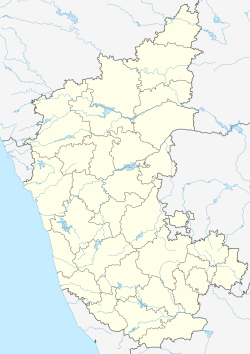| Sirsi Marikamba Temple | |
|---|---|
ಸಿರ್ಸಿ ಮಾರಿಕಾಂಬಾ ದೇವಸ್ಥಾನ | |
 Sirsi Marikamba Temple | |
| Religion | |
| Affiliation | Hinduism |
| Deity | Sirsi Marikamba Devi |
| Location | |
| Location | Sirsi |
| State | Karnataka |
| Country | |
| Geographic coordinates | 14°36′43″N74°50′22″E / 14.6119484°N 74.8395170°E |
| Architecture | |
| Style | Kavi art |
| Founder | Villagers |
| Date established | 1688 |
| Website | |
| marikambatemple | |
| Sirsi Marikamba Devi | |
|---|---|
Mother of Universe, Goddess of Power, Nourishment, Health, Motherhood, Rain and Harmony. | |
| Member of Tridevi Supreme Goddess in Shaktism | |
 Sirsi Marikamba Devi (Durga Devi ) | |
| Other names | Sirsi amma Maari amma Durga Devi Bhuvaneshwari Mahishasura Mardini |
| Kannada | ಸಿರ್ಸಿ ಮಾರಿಕಾಂಬಾ ದೇವಿ |
| Affiliation | Parvati, Durga, Kali |
| Abode | Sirsi |
| Mantra | Om Shri Sirsi Marikambeye Namha |
| Weapons | |
| Day | Tuesday and Friday |
| Color | Yellow (Turmeric) Red (Kunkuma) |
| Mount | Tiger |
| Texts | Folk, Mahabharata |
| Region | Malenadu |
| Ethnic group | Kannadigas |
| Festivals |
|
| Genealogy | |
| Born | |
| Consort | Shiva |
| Equivalents | |
| Tamil | Mariyamman |
| Sirsi Fair ಸಿರ್ಸಿ ಜಾತ್ರೆ | |
|---|---|
Sirsi Marikambe Rathotsava (Sirsi Marikambe rushing towards Mahishamandala/Bidkibail to slay demon Mahishasura) | |
| Status | Active |
| Genre | Fair |
| Begins | 19 March 2024 |
| Ends | 27 March 2024 [3] |
| Frequency | Biennial |
| Venue | Sirsi |
| Years active | 337 |
| Inaugurated | 1688 |
| Founder | Villagers |
| Previous event | 2022 |
| Attendance | 25,00,000+ [4] |
| Activity |
|
| Organised by | Sirsi Marikamba Temple |
| South India's Biggest Fair [5] | |
Sirsi Marikamba Temple is a Hindu temple dedicated to Marikamba Devi (Durga Devi), located in Sirsi, Karnataka, It is also known as Marigudi. It was built in 1688. Sirsi Shri Marikamba Devi is the "elder sister" of all Marikamba Devi's in Karnataka.







